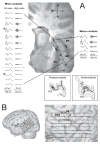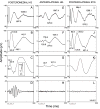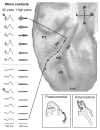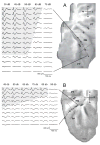Functional localization of auditory cortical fields of human: click-train stimulation
- PMID: 18207680
- PMCID: PMC5605818
- DOI: 10.1016/j.heares.2007.11.012
Functional localization of auditory cortical fields of human: click-train stimulation
Abstract
Averaged auditory evoked potentials (AEPs) to bilaterally presented 100 Hz click trains were recorded from multiple sites simultaneously within Heschl's gyrus (HG) and on the posterolateral surface of the superior temporal gyrus (STG) in epilepsy-surgery patients. Three auditory fields were identified based on AEP waveforms and their distribution. Primary (core) auditory cortex was localized to posteromedial HG. Here the AEP was characterized by a robust polyphasic low-frequency field potential having a short onset latency and on which was superimposed a smaller frequency-following response to the click train. Core AEPs exhibited the lowest response threshold and highest response amplitude at one HG site with threshold rising and amplitude declining systematically on either side of it. The AEPs recorded anterolateral to the core, if present, were typically of low amplitude, with little or no evidence of short-latency waves or the frequency-following response that characterized core AEPs. We suggest that this area is part of a lateral auditory belt system. Robust AEPs, with waveforms demonstrably different from those of the core or lateral belt, were localized to the posterolateral surface of the STG and conform to previously described field PLST.
Figures






References
-
- Arezzo J, Pickoff A, Vaughan HG., Jr The sources and intracerebral distribution of auditory evoked potentials in the alert rhesus monkey. Brain Res. 1975;90:57–73. - PubMed
-
- Bailey P, Bonin G. The Isocortex of Man. University of Illinois Press; Urbana: 1951.
-
- Binder JR, Frost JA, Hammeke TA, Bellgowan PS, Springer JA, Kaufman JN, Possing ET. Human temporal lobe activation by speech and nonspeech sounds. Cereb Cortex. 2000;10:512–528. - PubMed
-
- Brodmann K. Vergleichende Loakalisationslehre der Grosshirnrinde. J.A. Barth; Leipzig: 1909.

